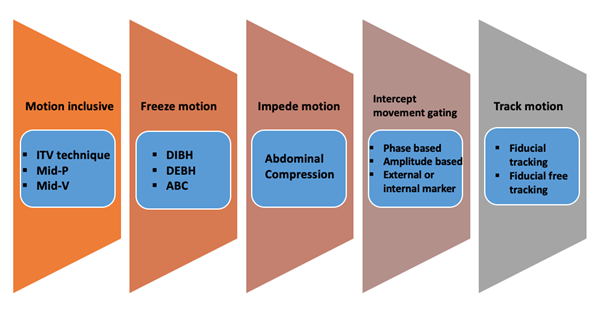The required precision brings challenges, particularly when it comes to managing tumour motion.Tumours in regions such as the lungs or liver are prone to movement due to breathing, organ filling, and patient motion, so that accurate targeting is difficult. For radiation therapists (RTTs), ensuring that SBRT’s precision is not compromised by motion requires advanced knowledge of motion management techniques, careful patient setup, and sophisticated image-guided technology. In this article, I review the importance of motion management in SBRT workflow (Figure 1) and the implications for RTTs in the delivery of safe and effective treatments.
modern radiotherapy centres, all designed to mitigate the effects of tumour and patient movement. RTTs must be proficient in using these techniques to ensure that the precision of SBRT is maintained throughout treatment.

Figure 2 Motion Management Strategies
Motion Inclusive
Internal target volume (ITV) technique: Respiration is correlated with tumour motion through the generation of images throughout respiration. With the help of 4D CT, optimal images are chosen for treatment and the size of the ITV can be decreased. Contouring takes place on one of the 4D scan phases and it is overlaid on another phase to expand the contour to generate the ITV.
Mid-position (Mid-P) and mid-ventilation (Mid-V): The Mid-P and Mid-V methods treat the breathing motion as a random error, which can be combined with other random margins when calculating the PTV margin. The shape of the tumour, with respect to that of the breath-hold CT scan, is better represented by the Mid-P reconstructions than by any of the 4D CT frames. The Mid-P scans contain about one-third of the noise of individual 4D CT scan frames.
The Mid-P approach uses information from all frames of the 4D CT scan instead of a single frame. This approach is more efficient than the Mid-V CT in terms of dose and CT information. The Mid-V CT scan is a single 3D CT frame of a 4D dataset, with the tumour closest to its mean position. To obtain this scan, first the tumour motion in the 4D CT scan is determined.
Freeze Motion
Deep Inspiration Breath-Hold (DIBH):It is a radiation therapy technique in which the patient takes a deep breath in and holds the breath while the radiation is delivered. The deep breath fills the lungs with air and the heart is moved away from the anterior chest wall. The radiation is delivered only at a defined threshold after deep inspiration. This technique is used mainly for left-sided breast cancer. The DIBH can be useful in situations in which radiation therapy is needed in the chest region as it avoids any dosage of radiation to the heart (Figure 3).
Deep Expiration Breath-Hold (DEBH): In the DEBH technique, the radiation is delivered only during the expiration of breath. This technique offers advantages in the treatment of pancreatic tumours, because it significantly reduces tumour motion and moves the OARs away from the target so that a minimum dose is delivered to the surrounding structure (liver, duodenum, stomach, etc).
Active Breathing Coordinator (ABC): ABC involves the use of a spirometer actively to suspend the patient's breathing at a predetermined position in the respiratory cycle. Its use reduces the movement of the organs in the chest and abdomen. If organ movement is restricted, the level of delivered radiation to the normal tissues that surround the tumour is reduced compared with the area that requires treatment. This technique is commonly used to treat left-sided breast cancers to reduce toxicity to the heart.
Impede Motion
Abdominal Compression: Respiratory motion is minimised with the application of abdominal pressure during pretreatment imaging and treatment delivery. This is a simple method to minimise respiratory-induced tumour mobility for both lung and liver lesions. Patients are forced to take shallow and fast breaths when the upper abdomen is pushed down by a pressure device, and this limits diaphragm movement. The pressure device, which is built into a stereotactic body frame, is usually controlled by the movement of a scaled screw, which enables the position of the compression plate to be reproduced for the entire treatment course.
Intercept Movement-gating
Respiratory gating: This is another important technique in SBRT, particularly in the treatment of tumours in the lungs or upper abdomen. In this approach, radiation is delivered only during specific phases of the patient’s breathing cycle when the tumour is in a predictable, stable position. Treatments can also be synchronised with respiratory motion by gating the treatments using a breathing monitor. By setting thresholds within the breathing monitor, the beam can be turned on and off at specific breathing amplitudes or phases. The most accurate way to monitor the target location is to observe it directly; however, in many cases, this is not possible. Fiducials can be placed in the target and monitored through the use of fluoroscopy or kV imaging, or if the fiducial is a transponder, through the use of technology designed for the transponder.
- Phase-based gating: In this approach, the radiation delivery is synchronised with a particular phase of the breathing cycle (often during exhalation) to ensure that the tumour is in the right place.
- Amplitude-based gating: A threshold is defined for the range of tumour motion, and radiation is delivered when the tumour is within this predefined range.
RTTs play a critical role in respiratory gating, as they are responsible for monitoring the patient’s breathing and ensuring that the gating system is correctly calibrated. This may involve instructing the patient on the correct breathing technique, as well as setting up the gating parameters to match the patient’s respiratory pattern.
Track Motion
Tumour tracking system: Tracking the tumours and simultaneously delivering radiotherapy is an attractive but challenging option. Tumour tracking relies on the interpretation of either internal or external surrogates timed with real-time delivery of radiation. Its use can significantly reduce the margins that are required, and therefore decrease the dose to OARs and the time required to deliver treatment compared with gating.
Advanced tumour tracking systems represent one of the most sophisticated approaches to motion management in SBRT. These systems allow for real-time tracking of the tumour’s position during treatment and adjustment of the radiation beams to follow the tumour as it moves.
- Fiducial markers: Small markers implanted near or within the tumour can be tracked using imaging systems. The radiation beams are continuously adjusted to ensure accurate targeting, even as the tumour moves.
- Surface tracking devices: Non-invasive tracking systems monitor the patient’s external surface to infer internal tumour motion and adjust the treatment delivery accordingly. RTTs are responsible for setting up and monitoring these tracking systems, and for ensuring that the tumour’s motion is accurately tracked and compensated for during treatment. This requires not only technical expertise but also the ability to troubleshoot and respond to any issues that arise during treatment.
Real-time delivery of radiation with simultaneous tracking of internal or external surrogates: Use of the CyberKnife™ radiosurgery system significantly reduces the margins that are required to decrease the dose to OARs. Tumour tracking relies on the interpretation of either internal or external surrogates with real-time delivery of radiation. Periodical tumour motion tracking is available with the CyberKnife system (Accuray Inc, Sunnyvale, California, USA) equipped with a compact 6MV(X-band) linear accelerator mounted on a robotic arm, and is designed to deliver radiation beams from many possible angles. An in-room orthogonal X-ray system periodically takes X-ray images of radio-opaque fiducials inside or close to the tumour. The locations of the fiducials are calculated from the orthogonal images and compared to the reference locations (Figure 4). If the difference exceeds tolerance, the robotic linear accelerator adjusts its direction to aim at the new location of the target volume.[6]

Figure 4 Illustration of CyberKnife™ system and target motion synchronisation
Advantages of dynamic target tracking with synchrony: Enhanced precision can be achieved through continuous tracking of and adjustment to the tumour's motion. Hence the system delivers radiation with unparalleled accuracy and exposure to surrounding healthy tissues is minimised. From the point of view of the patient, they can breathe normally during treatment sessions and therefore are more comfortable than when the breath-hold or breath-restriction techniques are used.
Artificial Intelligence (AI) role in motion management: AI is increasingly being integrated into radiotherapy workflows to enhance motion management. AI algorithms can analyse large volumes of imaging data in real-time to predict the movement of the tumour and adjust the radiation beams accordingly. By learning patterns of motion, AI can also help clinicians to personalise treatment plans based on the unique characteristics of each patient's anatomy and tumour motion.
RTTs’ responsibilities beyond technology involvement: While advanced technologies play a significant role in motion management for SBRT, the expertise and vigilance of RTTs remain indispensable during patient setup, motion monitoring, and patient counselling and communication.
Tumour motion is a crucial challenge for RTTs in SBRT: One of the main factors that influence the success of SBRT is the ability to account for tumour motion. This motion, especially in the thorax and abdomen, may be complex and unpredictable. RTT management of this motion is vital, as the success of SBRT relies on sub-millimetre accuracy. The complexity of this task has led to the development of several advanced motion management techniques, each of which requires a high level of expertise from RTTs.
Conclusion: Motion management is now seen as integral to the radiation therapy of many patients. In the precise world of SBRT, motion management is critical to the success of the treatment. For RTTs, the complexity of managing tumour motion demands a high level of technical expertise, clinical knowledge and patient care. From image guidance to respiratory gating and real-time tumour tracking, RTTs play a crucial role in ensuring that SBRT delivers its therapeutic promise. The role of the RTT in motion management during SBRT will only become more critical to the delivery of safe, effective, and personalised treatment.
References:
1. Onishi H, Shirato H, Nagata Y, et al. Hypofractionated stereotactic radiotherapy (HypoFXSRT) for stage I non‐small cell lung cancer: Updated results of 257 patients in a Japanese multi‐institutional study. J Thorac Oncol. 2007;2:S94–S100. [PubMed] [Google Scholar]
2. Jiang SB. Technical aspects of image‐guided respiration‐gated radiation therapy. Med Dosim. 2006;31:141–151. [PubMed] [Google Scholar]
3. Fassi A, Schaerer J, Fernandes M, Riboldi M, Sarrut D, Baroni G. Tumor tracking method based on a deformable 4D CT breathing motion model driven by an external surface surrogate. Int J Radiat Oncol Biol Phys. 2014;88:182–188. [PubMed] [Google Scholar]
4. Shirato H, Onimaru R, Ishikawa M, et al. Real‐time 4‐D radiotherapy for lung cancer. Cancer Sci. 2012;103:1–6. [PMC free article] [PubMed] [Google Scholar]
5. Houben J, McColl G, Ham Kaanders J, Smeenk RJ. Patient-reported toxicity and quality of life after hypofractionated high-dose intensity-modulated radiotherapy for intermediate- and high-risk prostate cancer
6. Zhang GG. Motion management in stereotactic body radiotherapy. Journal of Nuclear Medicine & Radiation Therapy. 2013;s6(01). doi:10.4172/2155-9619.s6-012

Subrata Roy
Senior executive radiotherapy technologist
Department of Radiation Oncology
HCG-ICS Khubchandani Cancer Centre, Mumbai, India
Email: roysubrata217@gmail.com